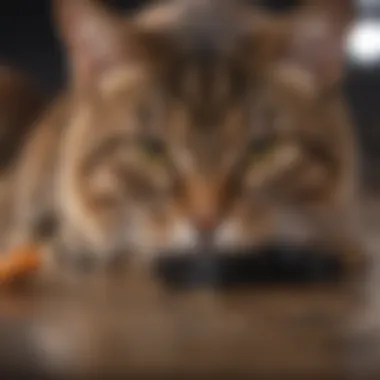Exploring the Implications of Shock Collars for Cats


Intro
The discussion surrounding the use of shock collars for cats carries significant weight within the realms of pet training and animal welfare. The increasing interest in these devices often raises questions about their effectiveness and ethical implications. This intricate topic requires a nuanced understanding, as it intertwines behavioral psychology with practical training methods.
As pet owners consider various approaches to training their feline companions, acknowledging the differing perspectives is crucial. While some advocate for shock collars, citing quick results in behavior modification, others argue against their use, highlighting the potential psychological harm inflicted on the animal. This article will dissect these contrasting views, offering insights into how shock collars impact cat behavior and well-being.
In addition, the exploration of alternative training methods will provide a broader context for understanding the best practices for cat training. By delving into this multifaceted topic, pet owners, educators, and animal advocates can achieve a more rounded perspective on the use of shock collars in feline training.
Understanding these dynamics is key to making informed decisions that contribute to humane and effective training practices.
Prologue to Shock Collars for Cats
The use of shock collars on cats raises significant discussion within the realms of animal training and behavioral management. Understanding this topic is crucial for various stakeholders, including pet owners, trainers, and veterinarians. This section aims to provide clarity on the concept and applications of shock collars, emphasizing the importance of informed decision-making.
Definition and Mechanism
Shock collars, also known as remote training collars, are devices designed to deliver an electric shock to the cat as a form of aversive stimulus. These collars work by emitting a mild electric shock when activated, usually via a remote control held by the owner. The purpose is to discourage undesired behaviors, such as excessive meowing or wandering off.
The mechanism involves a collar equipped with an electrical circuit that produces a shock upon stimulation. Some collars also include settings for vibration or sound, providing alternatives to physical pain. While proponents argue that these mechanisms can help reinforce training, there is an ongoing debate concerning the ethical implications of causing discomfort to an animal in training practices.
Purpose of Use
The primary purpose of using shock collars for cats is behavior modification. Many pet owners resort to these devices when they face difficulties in managing their cat's behavior. Common scenarios include:
- Preventing undesired behaviors: Some owners use shock collars to curtail excessive vocalization, furniture scratching, or litter box avoidance.
- Behavior reinforcement: The shock can serve as a deterrent, encouraging cats to associate specific actions with negative consequences.
- Monitoring outdoor activities: For outdoor cats, collars can help deter roaming beyond safe boundaries.
While the intention often stems from wanting a well-behaved pet, it is crucial to examine if this method aligns with the desired welfare for the animal. Understanding both the intended outcomes and the broader implications is vital for developing effective and humane training strategies.
Historical Context of Shock Collar Use
Understanding the historical context of shock collars for cats is crucial. This section provides insight into the development of these devices and how training methods have evolved over time. Historical background sheds light on the changing perspectives regarding the use of shock collars in animal training and their implications on behavior modification.
Development Over Time
Shock collars have a complex history that dates back several decades. They were initially developed for training dogs but soon gained popularity for use with cats. The original design featured basic electric stimulation to correct unwanted behaviors. Over the years, the technology has improved, resulting in devices that offer various intensity levels and modes of stimulation.
The introduction of remote control features offered pet owners better management of their cats' behaviors from a distance. This advancement raised questions about the effectiveness and ethics of using such a training method. In the context of cat training, there have been arguments both for and against shock collars, emphasizing the need for a thorough evaluation of their impact.
As societal attitudes toward pets have changed, so have the applications of shock collars. Our greater awareness of animal welfare and psychology influences the discussion surrounding these collars and their role in training. This historical backdrop is essential to assess their current place in pet training practices.
Shift in Training Techniques
The use of shock collars reflects a broader shift in training techniques for pets. Traditionally, aversive methods dominated animal training, focusing on correction rather than encouragement. However, there has been a gradual move towards positive reinforcement techniques in recent years.
Pet owners and trainers now seek methods that promote a stronger bond between humans and animals. Positive reinforcement encourages good behavior by rewarding desired actions, rather than punishing negative ones. This shift has led to the development of numerous tools that can help modify behavior without the need for shock collars.
Pet professionals emphasize understanding the animal's behavior instead of relying solely on punitive measures. This change highlights the growing awareness of animal welfare and the psychological impacts of training methods. Hence, the historical perspective of shock collar use illustrates the evolution of thought around animal training. This backdrop informs the present debate over their effectiveness and ethical considerations.
Effectiveness of Shock Collars in Cats
Understanding the effectiveness of shock collars for cats is crucial. These devices raise serious questions about training methods in pet care. Evaluating their performance requires a careful look at behavioral modification studies and the distinction between short-term and long-term outcomes. Pet owners, trainers, and veterinarians must consider the implications of using shock collars, balancing the potential benefits with ethical considerations.


Behavior Modification Studies
Several studies investigate the effectiveness of shock collars in changing feline behaviors. The objective is to determine if these collars can reliably alter unwanted actions, such as excessive scratching or inappropriate elimination. While some research indicates that cats may respond to the stimuli, the evidence often shows mixed results.
- Study Results: Some studies report short-term success in curbing certain behaviors. Cats may associate the unpleasant sensation with negative actions, leading to reduced occurrences. However, there remains a concern that while immediate behaviors can change, the underlying issues are not resolved.
- Long-term Observations: Long-term effectiveness is questionable. Some cats may become desensitized to the shocks, leading to a return of undesirable behaviors. This raises the question of whether shock collars truly modify behavior or merely create a temporary deterrent.
- Stress Considerations: A significant aspect of behavior studies involves observing stress levels in cats. Cats subjected to shock collars often exhibit signs of anxiety. This stress can impact the overall well-being of the animal, which must be weighed against any perceived benefits of using such devices.
Short-term vs Long-term Outcomes
The effectiveness of shock collars can vary dramatically between short-term and long-term scenarios. Understanding this distinction is vital for pet owners contemplating their use.
- Short-term Outcomes: Many users report quick results. Cats might refrain from unwanted behaviors immediately after experiencing a shock, leading to a perception that the collar is effective. Behavior modifications can occur, but these changes do not necessarily indicate a permanent solution.
- Long-term Outcomes: Over time, the intrigue of the collar may diminish. Cats might revert to their original behaviors as they adapt to or ignore the shocks. Additionally, the stress associated with the device can lead to further behavioral issues, making it a poor long-term strategy.
Research consistently shows that reliance on punishment-based methods, such as shock collars, can result in increased anxiety and stress, raising concerns for both pet welfare and owner satisfaction.
Ethical Considerations
The discussion surrounding shock collars for cats inevitably leads to ethical considerations. This topic is crucial as it weighs the benefits of such devices against their potential harm. A proper understanding of its implications is essential for pet owners, trainers, and even veterinarians. Each aspect carries significant relevance to both animal welfare and effective training methods.
Animal Welfare Perspectives
From an animal welfare standpoint, shock collars raise several contentious issues. The fundamental notion is whether these devices respect the intrinsic rights of the animals involved. Critics argue that exposing cats to any form of aversive stimuli undermines their well-being. This can manifest in psychological stress, anxiety, and even aggression.
Research indicates that negative reinforcement might not produce lasting behavior change. Instead, it could lead to fear-based responses, which are problematic for both the pet and the owner. The psychological impact often outweighs the short-term behavioral compliance the collar might achieve. Such effects can severely affect the human-animal bond, impairing trust and affection.
Moreover, understanding species differences in response is also significant. Cats, being more solitary and less domesticated than dogs, may react differently. Their need for predictability and security is well documented. Therefore, the unpredictability associated with shock collars could do more harm than good.
Legal Aspects of Use
The legality surrounding shock collars also presents intricate issues. Some regions possess strict regulations governing the use of such devices. This often stems from concerns about animal cruelty and the enforcement of welfare standards. It is vital for pet owners to be acquainted with local laws to avoid legal repercussions and ensure responsible pet ownership.
In certain jurisdictions, the sale of shock collars has been banned altogether. Various animal welfare organizations advocate for this prohibition. They believe that the overarching aim should focus on humane training practices instead of punitive measures. Legislation can vary widely; therefore, it's wise for users of shock collars to remain informed.
Alternatives to Shock Collars
Exploring alternatives to shock collars is essential for cat owners who seek effective training methods without causing harm or distress to their pets. There are numerous techniques available that can produce positive outcomes while also preserving the animal's welfare. Positive reinforcement methods, training aids, and tools all provide various options to manage behavior in a humane and effective manner. By emphasizing these alternatives, we can shift the focus from aversive training to more compassionate and effective solutions.
Positive Reinforcement Techniques
Positive reinforcement techniques center around rewarding desired behaviors rather than punishing unwanted ones. This approach employs treats, praise, or toys to reinforce good behavior in cats. For instance, when a cat uses a scratching post instead of the furniture, giving it a treat or verbal praise encourages the cat to repeat the action. This method not only promotes learning but also strengthens the bond between the cat and owner.
Some advantages of positive reinforcement include:
- Increased Motivation: Cats are more likely to engage in behaviors when there is a reward involved.
- Lower Stress Levels: This method fosters a calm environment for training, leading to less anxiety for the cat.
- Promotes Trust: Positive experiences help to build trust between the pet and owner, ultimately leading to better cooperation.
Overall, positive reinforcement strengthens the relationship and establishes a more effective training process.
Training Aids and Tools
Various training aids and tools can assist in behavior modification without resorting to shock collars. The use of these tools aligns with the objective of promoting safer and more humane training strategies. Some examples of effective training aids include:
- Clickers: These tools provide a distinct sound to mark a desired behavior. It is used in conjunction with treats to help cats understand what behaviors are being reinforced.
- Interactive Toys: Toys that stimulate a cat's natural instincts encourage active play, reducing the likelihood of negative behaviors like scratching or biting.
- Fencing and Barriers: Using barriers can prevent access to restricted areas, thereby managing behaviors effectively in a safe manner.
In summary, the pursuit of alternatives to shock collars reveals a multitude of positive methods to train cats. By integrating positive reinforcement and appropriate training aids, cat owners can enhance the training experience while prioritizing their pet’s well-being.


"Positive reinforcement is not just an effective training strategy, it is a pathway to a thriving pscyhe for our feline companions."
User Experiences and Testimonials
Understanding user experiences and testimonials is crucial to any discussion about shock collars for cats. These personal insights offer a glimpse into the practical outcomes of using these devices. They can reveal both the effectiveness and the drawbacks that may not be covered in research studies or theoretical discussions.
Personal stories shared by cat owners can provide invaluable context. Some owners report significant behavioral improvements in their pets, while others express regret after using shock collars. The varied experiences can lead to a better understanding of how these devices function in real-life situations, which is essential for informed decision-making by potential users.
While research offers quantitative data, testimonials add qualitative depth. They can highlight specific situations where shock collars succeeded or failed. Additionally, they help reveal the emotional toll that such decisions can impose on the animals and their caregivers. Thus, these narratives contribute to a more nuanced discussion about the overall implications of using shock collars in feline training.
Case Studies
Case studies serve to illustrate the outcomes of shock collar use through specific examples. Each case presents individual circumstances, highlighting the complexities involved in cat behavior modification.
One notable case involved a cat named Whiskers, who exhibited aggressive behavior towards other household pets. The owner decided to try a shock collar after various other training methods had failed. The initial results showed a decrease in aggressive behavior. However, over time, Whiskers developed anxiety, which led to other behavioral issues. This case serves to underline how a single solution can sometimes lead to unanticipated consequences.
Another example features a cat named Luna, whose owner committed to a combination of positive reinforcement and gradual training techniques instead of using a shock collar. The owner reported that this approach took longer but resulted in more stable behavior changes without stress on the animal.
These case studies emphasize the crucial need for pet owners to evaluate their choices carefully, considering both immediate results and long-term implications.
Managing Cat Behavior Without Collars
Many pet owners wonder if effective cat behavior management can be accomplished without resorting to shock collars. The answer is yes. There are various methods available that promote positive interactions between cats and their owners.
- Positive Reinforcement: Rewarding desired behaviors is often more effective than punishment. This includes treats, praise, or affection for good behavior. Over time, the cat learns to associate the behavior with positive outcomes.
- Structured Environment: Creating a safe and stimulating environment can minimize unwanted behaviors. This can include climbing trees, scratching posts, and varied playthings to keep the cat engaged.
- Consistency and Training: Regular and consistent training sessions help establish expectations. Using clear commands and cues can aid in effective communication between the owner and the feline.
- Gradual Behavioral Modification: Taking a gradual approach to changing behaviors allows cats to adapt and reduces stress.
Using these methods, many cat owners report success in managing their pets' behavior. Not only do these strategies often yield positive results, but they also enhance the overall bond between the cat and the owner, fostering trust and understanding.
Veterinary Insights on Shock Collars for Cats
Veterinary perspectives are crucial in understanding the implications and effectiveness of shock collars for cats. Veterinarians bring a wealth of knowledge regarding animal health and behavior, which can guide pet owners in their decision-making process. This section addresses veterinarians' opinions and the health risks associated with using shock collars, providing valuable insights that are backed by research and professional experience.
Veterinarians' Opinions
Veterinarians often emphasize the importance of using humane training methods. Many professionals believe that shock collars can lead to adverse behavioral responses in cats, including increased anxiety or aggression. They argue that alternative training methods, such as positive reinforcement, are safer and more effective in achieving desired behavior changes without causing distress.
Several studies indicate that cats trained with positive reinforcement respond more consistently and positively compared to those trained with shock collars. Veterinarians often encourage pet owners to consider these humane approaches.
“Training methods should prioritize the animal's welfare and mental health, rather than immediate compliance,” notes Dr. Emily, a practicing veterinarian with over 10 years of experience in feline behavior.
Health Risks Associated
There are several health risks associated with the use of shock collars on cats. These devices can cause physical harm, such as skin irritation or burns, particularly if used improperly. Additionally, the stress caused by the shocks can lead to long-term psychological trauma, resulting in behavioral issues.
Potential health risks include:
- Physical Injuries: Prolonged use of shock collars may cause burns or hair loss around the neck area.
- Behavioral Changes: Anxiety and fear can develop, leading to increased aggression or withdrawal.
- Stress-Related Illnesses: Chronic stress may manifest as health problems like gastrointestinal issues.
Veterinarians frequently recommend regular check-ups to monitor physical health if shock collars are used. They also suggest alternative behavior management strategies to mitigate these risks.
In summary, veterinary insights shed light on the risks and considerations surrounding shock collars for cats, urging cat owners to consider the well-being of their pets above all else.
Cultural Perceptions of Shock Collars


Cultural perceptions play a significant role in shaping attitudes towards shock collars for cats. Different societies have varying beliefs and practices when it comes to animal training and behavior modification. Understanding these perceptions is crucial for both pet owners and professionals in the field, as it influences the acceptability and usage of shock collars.
Regional Differences in Acceptance
Acceptance of shock collars can vary widely between regions. In some areas, these devices are seen as practical tools for training pets, while in others, they are viewed as inhumane or cruel.
- North America: In many parts of the United States and Canada, shock collars are commonly used. Many trainers advocate for their effectiveness, citing positive immediate results.
- Europe: The European Union has stricter regulations regarding the use of shock collars. Countries like Germany and Sweden have banned their use altogether, reflecting a strong cultural emphasis on animal welfare.
- Asia: Cultural attitudes in countries like Japan may lean towards less harsh training methods, preferring positive reinforcement strategies instead of aversive techniques like shock collars.
The divergence in acceptance often stems from differing beliefs about animal rights and the ethics of training methods. This gap can lead to varying levels of enforcement and usage, significantly impacting the training practices veterinarians and pet owners employ.
Impact of Media Representation
Media representation can significantly affect public opinion about shock collars. Television shows, online videos, and social media discussions contribute to a collective understanding of these devices. The portrayal of shock collars in popular media can either normalize their use or cast them in a negative light.
- Documentaries: Some documentaries focus on animal training methods, showing shock collars in a positive context. This can lead to an increase in their acceptance among viewers who see them as effective tools.
- Social Media: On platforms like Reddit and Facebook, conversations about pet training can sway opinions. Posts highlighting distress caused by shock collars can raise awareness around their potential hazards, leading to public outcry and demands for bans.
Ultimately, the changing views in media play a critical role in shaping how society perceives not just shock collars, but also pet training methods in general. This awareness can lead to a broader discussion about ethics, efficacy, and animal welfare, influencing future legislation and the development of new training techniques.
“Cultural context is essential. What may be acceptable in one region could be frowned upon in another.”
Future Directions in Cat Training
As society evolves, both pet ownership and animal training methods are undergoing significant transformations. This is especially important when discussing cats, which have unique behavioral traits compared to other pets. Future directions in cat training reflect emerging philosophies and techniques aimed at promoting healthier behaviors in feline companions while considering ethical implications.
Emerging Technologies
Technological advancements offer promising new tools for cat training. For instance, the use of smartphone applications can now assist owners in tracking their cat's behavior and progress over time. Some apps provide interactive learning experiences, gamifying the training process. This creates engagement for both the pet and owner, fostering a productive and enjoyable learning environment.
Moreover, wearable technology such as smart collars can monitor a cat's health metrics and activity levels. These collars allow owners to gain insights into their pet's behaviors, such as aggression or anxiety triggers. By understanding these triggers, owners can properly adjust their training methods to accommodate their cat's specific needs. The integration of technology thus stands to enhance the training experience, making it more data-driven and tailored to each individual's requirements.
Shift Toward Holistic Approaches
In recent years, there has been a noticeable shift toward holistic approaches in pet training. This encompasses not just physical training but also the emotional and psychological well-being of the animal. Positive reinforcement techniques, such as rewarding desirable behavior, have gained traction. This is often contrasted with more punitive methods, such as shock collars.
Many trainers and behaviorists advocate for a balanced approach that considers the emotional states of cats. Understanding feline anxiety, stress signals, and environmental factors can lead to better training outcomes and healthier relationships between pets and owners. Simple routines, enriching environments, and consistent positive reinforcement can effectively guide behavior modification.
In summary, the future of cat training is evolving with promising technologies and holistic methods that emphasize well-being. By focusing on the individual needs of each cat, owners can foster a harmonious living environment that promotes effective training without compromising the animal's welfare.
"The real key to training success lies not in force, but in understanding the unique psyche of each cat."
This evolving landscape of training provides both challenges and opportunities for pet owners, educators, and veterinarians alike.
Ending
The discussion surrounding shock collars for cats is not just about training methods but also encompasses broader themes of animal welfare, ethical considerations, and the responsibilities of pet ownership. Understanding the full context in which these devices are used is crucial for several reasons. First, it allows pet owners to make informed decisions about their training methods. Second, it highlights the need for ethical practices in training animals. The implications of using shock collars extend beyond immediate behavioral modification.
Recognizing the potential benefits and drawbacks is essential. On one hand, these collars can offer a quick solution for certain behavior issues. On the other hand, they can lead to stress and anxiety in pets. Pet owners must weigh these aspects carefully, as their choices affect not only their cats but also the overall perception of animal training practices in society.
Summary of Key Points
- Effectiveness: Studies show mixed results regarding long-term behavioral modification through the use of shock collars.
- Ethics: There are considerable concerns about animal welfare and the ethical implications of using aversive training techniques.
- Alternatives: Positive reinforcement methods are increasingly preferred by trainers and veterinarians as humane alternatives.
- Veterinary Insights: Veterinary professionals generally advise against the use of shock collars due to potential health risks and behavioral issues.
- Cultural Perception: Attitudes toward shock collars vary widely across regions, influenced by media and social norms.
Recommendations for Pet Owners
For pet owners considering the use of shock collars, the following recommendations may help guide decision-making:
- Consult Professionals: Before using a shock collar, speak with a qualified veterinarian or animal behaviorist to explore all options.
- Educate Yourself: Understand the specific behaviors you wish to modify and assess whether a shock collar is necessary.
- Explore Positive Reinforcement: Look into training methods that reward desired behaviors without the use of aversive techniques.
- Monitor Reactions: If a shock collar is used, closely observe how your cat responds over time, adjusting methods based on their reactions.
- Stay Informed: Keep up with the latest research on training methods and animal behavior to ensure you are utilizing the most effective and humane practices available.
The welfare of your pet should always come first. Consider the long-term implications of any training method and prioritize compassion and understanding in your approach.















